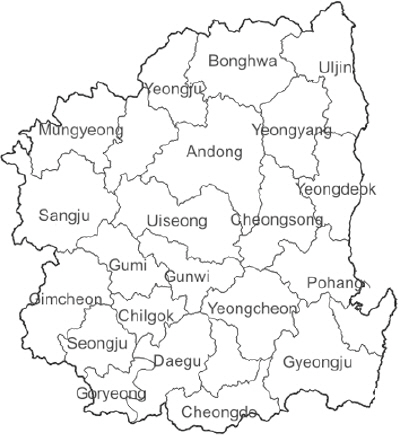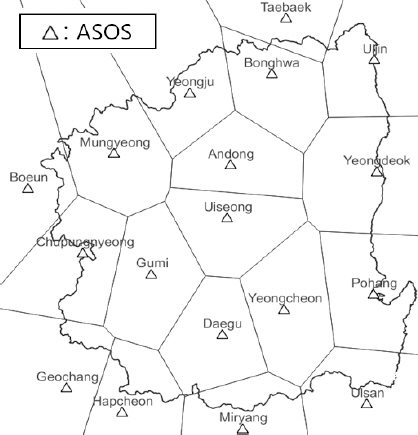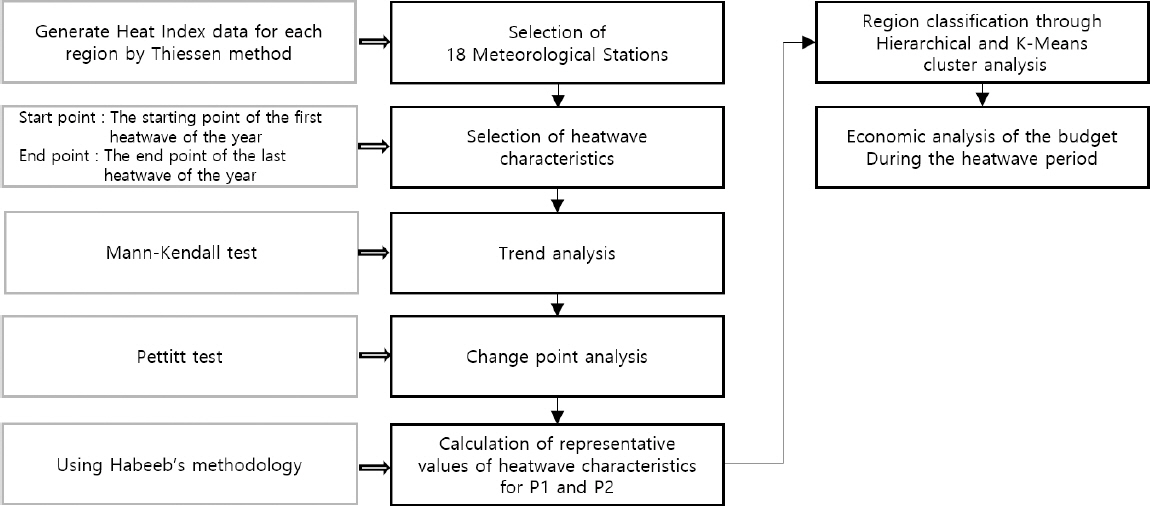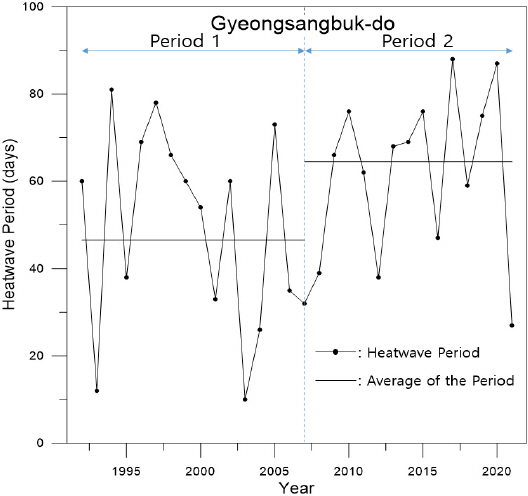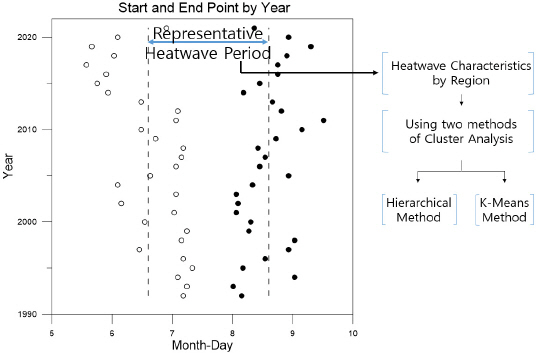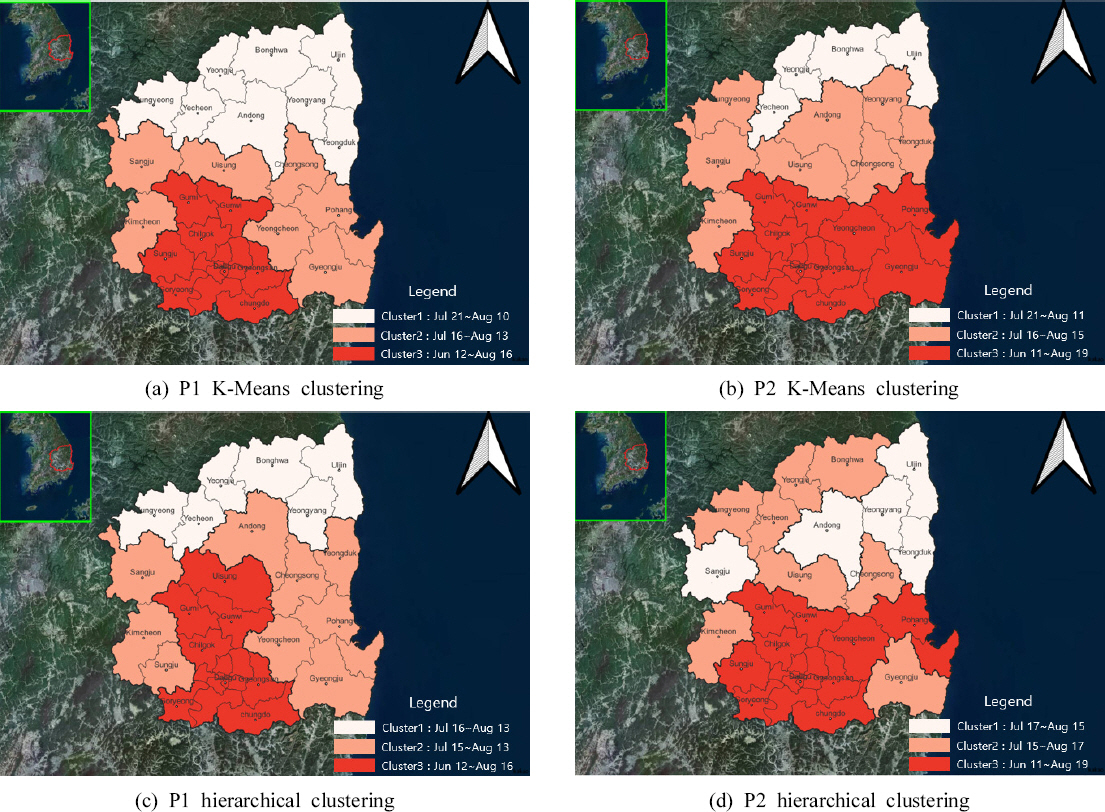 |
 |
- Search
| J. Korean Soc. Hazard Mitig. > Volume 23(1); 2023 > Article |
|
Abstract
A heat wave countermeasure period was selected and operated to minimize the damage from heat waves in Korea. However, to this date, there are no clear ideas and methodology for selecting a heat wave countermeasure period, resulting in continuous budget expenditure incurred for its preparation and response activities. This requires an efficient selection of countermeasure periods. This study analyzed the time series data trend of heat index using Mann-Kendall and Pettitt test for cities and counties in Gyeongsangbuk-do, and it confirmed the current characteristics of increasing heat waves compared to- those in the past. In addition, K-means cluster analysis was applied to derive the city-wise heat wave characteristics. The cities and counties were classified into three based on the heatwave characteristics and starting point and ending point of each heat wave characteristic representing the years 2004 to 2021 between July 21 to August 11, July 16 to August 15, and July 11 to August 19. It was also confirmed that there was a significant difference from the heat wave countermeasure period (May 20~Sep 30) currently selected. Hence, in the future, economic losses may be minimized in terms of disaster preparedness and response through the selection of the heatwave countermeasure period reflecting temporal and spatial characteristics.
요지
우리나라에서는 폭염피해를 최소화하기 위해 폭염대책기간을 선정하여 운영하고 있다. 하지만, 명확한 폭염대책기간 선정 근거와 방법론은 제시되고 있지 않은 실정이며, 이 과정에서 대비 및 대응 활동에 지속적인 예산 지출이 발생하여 효율적인 기간 선정의 필요성이 대두되고 있다. 이 연구는 경상북도 시군을 대상으로 Mann-Kendall test와 Pettitt test를 이용해 일 최고체감기온 시계열 자료의 경향성을 분석하여 과거보다 증가한 폭염특성을 확인하였다. 추가적으로 K-Means 군집분석을 적용하여 시군별 폭염특성을 연구결과로 도출하였다. 시군은 3개의 폭염특성으로 구분되었으며, 각 P2 (2004년부터 2021년)를 대표하는 각 폭염특성의 시종점은 7월 21일부터 8월 11일(21일), 7월 16일부터 8월 15일(30일), 7월 11일부터 8월 19일(39일)로 나타나 현재 운영중인 폭염대책기간(5/20~9/30)과는 크게 다름을 확인할 수 있었다. 향후, 시⋅공간적 특성을 반영한 폭염대책기간 선정을 통해 재난 대비 및 대응 측면에서 경제적 손실을 최소화하는 방안으로 제시될 수 있을 것으로 판단된다.
전세계적으로 폭염에 의한 피해는 커지고 발생 기간이 확대⋅증가되고 있다. 2022년 미국과 유럽에 때 이른 폭염현상이 나타나 건조상태가 지속되어 산불, 철도 운행 중지 등 수백 명의 피난민이 발생하거나 경제적 손실을 야기했다. 이러한 폭염을 효과적이고 확실하게 대비 및 대응하기 위해 우리나라에서는 폭염대책기간을 운영하고 있다. 국내에서 운영되고 있는 폭염대책기간은 5월 20일부터 9월 30일까지이며, 전국적으로 동일하게 적용된다. 하지만 이와 같은 획일적인 기준은 지역별 상이한 기후 및 지형적 특성을 반영하지 못한다. 또한, 폭염대책기간의 시점과 종점을 여름철 전후에 여유기간을 두어 설정하는 등 모호한 기준을 통해 대책기간을 운영하고 있다. 현재와 같은 획일적인 대책기간 운영을 지속할 경우 폭염이 발생하지 않는 기간까지 비용과 인력이 사용되어 경제적 손실을 야기할 가능성이 있다.
IPCC (Intergovermental Panel on Climate Change) 5차 보고서에서는 연평균온도가 1.5 ℃ 상승할 경우 폭염의 강도는 심화되며, 빈도는 잦아질 것으로 예상하였다. 한국 기후변화 평가보고서 2020은 IPCC를 기반으로 국내 실정에 맞게 구성하여 발간하였다(KME, 2020). 보고서 분석 결과에 따르면 21세기 말의 평균기온은 +1.9~5.2 ℃ 상승하는 것으로 나타났으며, 한반도 폭염 발생 빈도, 강도 및 지속성이 증가하고 있음을 확인하였다. 또한, Lee and Heo (2011)는 우리나라 여름철 온도의 상승과 열대야와 열대일의 증가 경향이 뚜렷함을 확인하였으며, 선행연구들을 통해 시간에 따른 기후변화와 그에 따른 폭염 양상의 변화를 확인하였다. 폭염 양상의 변화를 확인하기 위한 경향성 분석에서 Choi et al. (2018)은 평균 기온 시계열 자료의 경향성을 선형 추세로만 분석하는 것은 한계가 있음을 언급하였으며, 이를 보완하기 위해 변동점 분석을 수행하였다. 또한, Jin et al. (2021)은 40년간 축적된 남한지역의 연평균 기온 및 계절별 기온 시계열 자료에 대한 경향성 분석을 수행한 뒤, 변동점 분석을 추가로 수행하였다.
기후 특성에 따른 지역 세분화에 관한 연구는 국내⋅외에서 활발히 진행되고 있다. Kyoung et al. (2007)은 강수특성을 고려해서 기후를 지역적으로 구분하였으며, 가뭄의 특성을 이용하여 전국에 대해 공간적 군집분석을 진행하였다. Wang et al. (2022)는 낙동강 유역의 강우관측소 강우자료를 이용하여 경향성 분석과 K-Means 군집분석을 수행하였고, Park (2015)은 극한기우지수(열대일수, 호우일수)의 20년 단위의 군집분석을 수행하였다. Kim et al. (2017)은 기온과 강수량 자료를 이용하여 국내 관측소 지점을 기준으로 K-Means 군집분석 방법을 통해 월별 변화를 확인하였으며, Jung et al. (2008)은 우리나라 기상관측자료(평균온도, 최고온도, 평균습도 등)를 활용한 군집분석 방법을 적용하여 지역별 풍향 및 풍속의 특성을 고려한 3개 권역으로 구분하였다. Lee et al. (2022)은 군집분석을 활용하여 폭염재난 발생 시 서울시 시민의 활동패턴을 분석하고 그 특성에 따라 취약지역을 구분하였다. 그러나 폭염 특성에 따른 군집분석을 활용한 지역적 구분 연구는 매우 미흡한 실정이다.
해외에서는 영국의 경우 폭염 계획 연구 보고서에 전역을 9개 지역으로 구분하였고(HSA, 2015), 호주의 경우에는 해상예보를 기준으로 구역을 구분하여 호주 국토를 7구역으로 구분하여 기상 예보 및 특보를 제공하고 있음을 확인하였다(KMA, 2018). 이를 통해 폭염 특보 기준과 기간을 구분하여 운영함으로써 대책기간 동안의 관리의 효율성을 극대화한 것을 확인하였다.
이 연구에서는 폭염 발생의 유사성을 가진 지역들을 구분하여 대책기간 운영을 위한 자료를 제공하고자 하였다. 따라서 군집분석 방법을 활용하여 경상북도 시⋅군별 기후특성을 반영한 폭염대책기간 운영방안을 제시하였으며, 이에 따른 경제적 효과를 분석하였다. 군집분석에 활용된 지역별 폭염기간 대푯값 산정에는 Habeeb et al. (2015)의 방법론을 활용하였다.
이 연구는 지역별 기후 특성을 고려하여 폭염특보 구역을 세분화하는 데 목적이 있다. 이에 따라 지역별로 기후 특성이 상이한 경상북도 지역 내 1개 광역시, 10개 시, 13개 군을 연구 대상지역으로 설정하였다(Fig. 1). 경상북도는 산으로 둘러싸인 내륙지방 및 분지 지역과 해안의 영향을 받는 동해안 지역, 낙동강의 영향을 받으며 지대가 낮은 중앙 저지대 등 여러 지형에 따른 상이한 기후 특성을 가지고 있으며(KMA, 2012), 이러한 특성에 의해 연구 목적에 적합한 지역으로 판단되었다. 울릉군의 경우 그 위치가 타 지역에 비해 크게 달라 연구 대상지역에서 제외하였다.
Ahn et al. (2000)은 강우량을 통한 분석에 최소 30년 이상의 자료를 사용할 경우 안정된 확률강우량을 산정할 수 있음을 언급하였다. 따라서 장기간에 대한 변동성 분석을 위해 연구의 시간적 범위는 1992년부터 2021년까지(30년)으로 설정하였으며, 이 기간 동안의 기상청 관측자료를 통해 연도별⋅지역별 폭염기간을 도출하여 연구에 활용하였다. 또한, 최근 지속적으로 발생하고 있는 기후변화에 따른 폭염기간의 경향성 추세를 확인하기 위해 분석을 하였고, 분석을 통해 구분된 변동점 전⋅후에 대해 각각 군집분석을 수행하여 비교⋅분석하였다.
우리나라는 2007년부터 폭염특보제를 운영하여 폭염발생의 유무를 확인할 수 있지만 폭염특보의 가용한 자료 개수의 제한으로 분석에 사용하기엔 한계가 있다. 이를 보완하기 위해 기상청 기상관측소의 일 최고체감기온자료를 사용하여 지역별 폭염자료를 구축하였다. 지역별 폭염자료 구축을 위한 기상관측소 선정 기준은 1992년부터 2021년까지(30년)의 자료를 가지고 있으며, 기상청의 종관기상관측소(ASOS)인 곳으로 하였다. 다만, 기온은 지역별 편차가 매우 커 관측소의 오차를 줄이기 위하여 다수의 지점을 선정할 필요가 있다. 하지만 방재기상관측(AWS)의 관측소 지점은 가용한 습도자료 수의 제한으로 인해 일 최고체감기온 산정에 한계가 존재하여 제외하였다. 결과적으로 경상북도 인근의 18개의 기상관측소가 선정되었다(Table 1). Kim et al. (2022)는 전 처리된 ASOS 지점 데이터를 티센가중치법을 통해 시군 단위로 변환하였으며, 변환된 일 최고기온 데이터를 통합하여 폭염 사상 데이터를 분리하였다. 이 연구에서는 각 관측소별 일 최고체감기온자료를 통해 Thiessen 가중평균법을 적용하여 시⋅군 단위의 기온자료로 변환하였으며, 이를 통해 지역별 폭염 발생자료를 구축하였다(Fig. 2).
Detailed Information by Point of ASOS Meteorological Observatory
Thiessen 가중평균법은 각 관측소를 연결한 선상에 수직 이등분선을 그어 이선으로 구성된 다각형 지배 면적에 대한 가중치를 반영하여 산출하는 방법이다. 가중평균법으로 식별한 지역별 일 최고체감기온자료를 통해 시⋅군별 폭염의 발생을 식별하였다. 이때, 폭염발생의 기준은 기상청에서 운영하고 있는 폭염특보제의 주의보 발령기준(기온과 습도를 고려하는 체감온도 기준으로 33 ℃ 이상의 기온이 2일 이상 지속될 경우)을 충족하는 경우로 하였으며, 폭염의 발생에 따른 폭염기간을 지역과 연도별로 선정하였다. 하지만 폭염사상을 특정하는 연구는 미비하기 때문에 폭염기간을 선정하는 기준이 모호한 실정이다. 따라서 이 연구에서는 해당연도에서 식별된 첫 폭염의 시점과 마지막으로 발생한 폭염의 종점의 사이의 기간을 기준으로 폭염특성을 산정하였다. 이 폭염특성을 연도별⋅지역별로 확인하여 다음 과정에서 기후변화에 따른 폭염특성의 변화를 확인하고자 하였다.
이 연구에서는 지역적 기후 차이에 따른 시⋅군별 폭염특성의 상이성 분석 및 폭염 대책기간 운영 기간을 제안하고자 하였으며, 또한 새로운 대책기간의 적용에 따른 경제적 이익을 개략적으로 추산하고자 한다.
이를 위해 경상북도 인근 기상관측소를 선정하고 일 최고체감기온자료를 수집하였다. 지역별 폭염의 발생을 확인하기 위하여 기상관측소별 기온자료는 Thiessen 가중평균법으로 관측소별 가중치를 곱하였으며, 시⋅군별 일 최고체감기온자료로 가공하였다.
또한, 기후변화에 의한 폭염기간의 변화를 확인하고자 연도별⋅지역별 폭염특성 자료를 구축하였다. 그 후, 폭염특성을 변수로 이용하여 기간에 따른 변화 양상을 확인하고자 Mann-Kendall test와 Pettitt test를 수행하였으며, 변동점 전⋅후의 폭염기간 대푯값을 산정하였다. 도출된 결과는 군집분석 방법에 따라 지역적 폭염 발생 유형의 변화를 확인하는데 사용되었다.
마지막으로 군집분석 결과를 새로운 폭염대책기간으로 적용할 경우 어느정도의 예산절감이 가능할지 폭염대책기간과 폭염기간의 비율에 따른 일일 지출 고정비를 확인하여 비교⋅분석하였다. 전체적인 연구의 흐름도는 Fig. 3에 나타내었다.
Mann-Kendall test는 세계기상기구(World Meteorological Organization)가 기상자료의 경향성 분석을 수행할 때 권장하는 검정방법이다(Jin et al., 2021). 따라서 이 연구에서는 Mann-Kendall test를 이용하여 지역별 폭염특성의 변화 추세를 확인하고자 하였다. 분석 과정은 다음과 같다.
추세분석 시 Eq. (1)을 이용하여 xj와 xk의 크기 비교를 수행한다. Kendall 통계량 S는 Eq. (2)와 같이 정의한다.
S의 분산은 Eq. (3)의 과정을 거치며, 통계값 Z는 Eq. (4)로부터 산정할 수 있다.
결론적으로 Eq. (4)를 통해 확인할 수 있는 검정통계량 Z값의 부호에 따라 추세 방향을 확인할 수 있다.
지역별 폭염특성의 추세 방향은 Table 2와 같이 폭염특성의 변화가 크지 않은 봉화를 제외한 지역에서 증가하는 추세임을 확인하였다. 이는 폭염특성이 시간이 지남에 따라 증가함을 나타내는 것을 확인할 수 있었다.
Trend Analysis Using Heatwave Characteristic Data
이 연구에서는 기후변화로 인한 폭염특성의 변화 여부를 확인하고, 이에 대응할 수 있는 새로운 폭염대책기간 제시를 위해 선행적으로 Pettitt test를 활용하였다. 1992년부터 2021년의 기간 동안의 지역별⋅연도별 폭염특성을 사용하여 변동점을 확인하였다. 이후 분석에서 변동점 전후로 구분된 기간마다 폭염특성 대푯값을 산정하고자 하였다.
Pettitt test는 비모수 검정 방법 중 하나로 자료의 분포를 가정하지 않고 변동점의 존재 여부를 검정하여 시계열에서의 변화점을 발견하는데 유효하다. 유량자료, 강우, 수질 및 기온 등의 여러 수문자료와 관련한 연구사례가 다수 존재한다(Lee et al., 2010; Kim and Lee, 2018; Jin et al., 2021).
시계열 T(x1, x2,...,xt)는 t시점을 기준으로 전반부 자료 P1(x1 ,x2 ...,xn)과 후반부 자료 P2(xt+1,xt+2,...xT)두 개의 자료로 나누어지며, 시점 전⋅후의 구간은 Eq. (5)의 검정 통계량 (KT)는 지수U(t)를 통해 계산되며, Eqs. (6) and (7)로 나타내었다.
각 변화점에 대한 신뢰수준을 Eq. (8)과 같이 계산하여 유의확률(p)과 유의수준(α)의 비교를 모든 데이터에 적용하여 진행하였다.
Pettitt test 결과로 도출된 변동점의 전과 후에 대하여 각각 Period 1 (이하 P 1), Period 2 (이하 P 2)로 설정하였다(Fig. 4).
경상북도 행정구역별 Pettitt test를 수행하여 각각의 결과는 유의확률p< 0.05를 충족하여 모든 지역이 유의한 결과를 가진 것으로 확인하였다(Table 2).
신뢰도 검정 결과 최종적으로 경상북도의 변동점 결과와 각 도시의 변동점 결과값의 평균이 2003년으로 동일하게 나타남을 확인하였다. 이는 1992년부터 2021년까지의 기간에 대해 뚜렷한 폭염기간의 변화를 보이는 해가 2003년임을 알 수 있다.
이후 분석에서는 Pettitt test로 도출된 결과로 구분된 P 1 (1992~2003년), P 2 (2004~2021년)에 대해 각각 Habeeb et al. (2015)의 방법에 따른 지역별 폭염특성 대푯값을 선정하고자 하였다.
미국환경보호국(EPA)은 Habeeb et al. (2015)의 폭염기간 대푯값 산정방법을 채택하여 분석결과를 공개하고 있으며, Habeeb et al. (2015)은 각 년도의 첫 폭염 시점 및 마지막 폭염의 종점을 확인하여 10년 단위의 폭염기간 대푯값을 유도하였다. 본 연구에서는 해당 연도의 첫 폭염의 시점과 마지막 폭염의 종점을 폭염기간으로 정하고 폭염특성이라 가정하여 방법론을 활용하였다. 지역별 폭염특성 대푯값 선정은 기간에 따른 각 년도의 폭염특성 평균을 통해 구하며, 그 과정에 대한 개념도를 Fig. 5에 나타내었다. 지역별⋅기간별 폭염특성 대푯값은 대푯값 선정과정을 P 1, P 2로 구분하여 적용하여 도출하였으며, 이후 선정된 결과를 군집분석하여 기후변화로 인한 군집 양상의 변화를 확인하는 데 사용되었다.
군집분석은 유사하거나 서로 관련 있는 항목끼리 몇 개의 집단으로 분류하는 것이다. 방법에 따라 크게 계층적 군집분석 방법과 비계층적 군집분석 방법으로 구분하며 서로 다른 특징을 지니고 있다. 군집분석에는 병합 시 기준이 필요하며 그 변수로 지역별 폭염특성을 사용하였다.
계층적 군집분석 방법은 각 개체를 하나의 군집으로 취급하여 단계별로 대상을 병합하는 방법으로 구현이 간단하고 군집 수를 사전에 결정할 필요가 없다. 또한, 병합 과정을 Dendrogram을 통해 시각적으로 확인이 가능하다는 특징을 가지고 있으며, Yeo (2011)는 기상인자인 기온, 습도, 강우량에 대해 계층적 군집분석 방법을 적용하여 지역적 차이를 확인한 바 있다.
비계층적 군집분석은 K-Means 방법이라고도 하는데 이는 비계층적 군집분석 방법에서 가장 많이 사용되고 있기 때문이다(Kyoung et al., 2007; Yoo et al., 2010). 이에 따라, 비계층적 군집분석 방법으로 K-Means 방법을 채택하였다. 이 방법은 n개의 개체를 g개의 군집으로 나누는 과정에서 모든 방법을 점검해 최적화된 군집을 형성하는 방법이다. 하지만 초기 군집 수를 설정하기 어려운 단점을 가지고 있어 다양한 방법으로 이를 보완하였다. Elbow Method는 그중 하나로 객체(χi)와 군집(j)의 중심(c)에 대해 군집간 분산(Within cluster Sum of Squares, WSS)과 전체 분산(Total Sum of Squares, TSS)의 비율을 보고 판단하는 방식이며 Eqs. (9) and (10)과 같이 정의된다. 군집 개수에 따라 분석을 진행하여 급격한 수치 변화가 나타날 때 최적 군집 수로 설정한다.
두 가지 군집분석 방법은 다른 방식으로 군집을 유도하기 때문에 결과가 상이할 수 있다. 따라서 두 방법에 대한 군집분석을 진행하고 더욱 적합한 방법을 채택하여 폭염특보 구역을 세분화하였을 때의 경제적 이익을 개략적으로 파악하고자 하였다.
이 연구에서는 과거자료만을 이용하여 P 1, P 2의 기간 별 폭염특성 대푯값을 기준으로 군집분석을 수행하였다. 분석 결과 사용된 자료만을 이용하였을 때에도 기간에 따른 폭염특성 발생의 변화양상의 변화가 나타났다. 군집분석 결과의 군집1은 다른 군집들에 비해 상대적으로 폭염의 발생이 적고 그 기간이 짧았으며, 군집3의 경우에는 상대적으로 폭염 발생이 잦고 그 기간 또한 긴 것으로 나타났다. 군집 2는 군집1과 군집3의 사이에 위치하여 폭염특성이 중간값을 가지는 것을 확인하였다. 지리적 특성에 따른 분석 결과 K-Means 방법은 지리적 위치를 통해 구분할 수 있었으나, 계층적군집분석 결과에서는 군집1과 군집2이 지리적으로 혼합되어 나타남을 확인할 수 있었다. 각 군집분석에 따른 결과는 Fig. 6에 나타내었다.
K-Means 군집분석 결과를 통해 기후변화 양상을 확인하여, Figs. 6(a)와 (b)에 결과를 나타내었다. P 1 (1992~2003년)의 군집1에 해당하는 지역은 문경, 예천, 안동, 영주 등으로 경상북도 기준 고위도에 분포하는 특징을 보였다. P 2 (2007~ 2021년)에서는 폭염특성의 상승 폭 차이에 의해 문경, 안동, 영양, 영덕 지역이 제외되어 군집의 크기가 줄어든 것을 확인하였다.
P 1의 군집3에서는 대구, 영천, 성주, 고령, 청도 등의 지역이 포함되어 있었으며 대체로 저위도 내륙지역에 위치하였다. 반면, P 2에서는 포항, 영천, 경주가 추가되어 군집의 크기가 커진 것을 확인할 수 있었으며, 내륙지역의 분지 뿐만 아니라 저위도 해안가 지역도 포함되었다. P 1, P 2에서의 군집2는 중위도에 위치하였으나 P 2에서의 군집 위치가 상대적으로 고위도에 위치하였다. 기존에 폭염의 발생이 적고 그 기간이 짧았던 군집1의 크기는 줄어들고 반대로 군집3의 크기가 커진 것을 통해 경상북도 내 시⋅군은 기간에 따른 폭염특성이 더욱 커짐을 확인하였다.
계층적 군집분석의 결과는 Figs. 6(c)와 (d)에 나타내었다. Fig. 6(c)의 P 1군집1에 봉화, 영주, 울진 등이 포함되었으며, 군집 중에서 가장 짧은 폭염특성을 나타내었다. P 2에서는 군집에 안동, 영양, 영덕, 상주가 추가되었으며, 문경, 예천, 영주, 봉화가 제외되었다. P 1, P 2의 군집3 결과는 기존 대구, 경산, 청도 등의 지역에서 의성이 제외되고 영천 포항이 추가되었다. 군집2는 구성 지역과 위치가 크게 변화하였다. 이는 계층적군집분석의 결합 방식에서 차이가 발생한 것으로 가까운 위치에 분포하여 한 번 결합된 개체가 다시 분리되어 군집에 결합되지 못하였기 때문으로 확인되었다.
결과적으로 K-Means의 결과가 IPCC 5차 보고서(IPCC, 2014)의 폭염의 크기와 발생빈도 등이 지속적으로 증가하는 변화 양상 내용과 더욱 비슷함을 확인하였다. 따라서 이 연구에서는 K-Means 방법이 더 신뢰성이 높다고 판단하였으며, P 2결과(Fig. 6(b))를 적용하여 현재 기준으로 폭염특보를 세분화할 경우 발생 가능한 경제적 이익을 계산하고자 하였다.
군집별 폭염대책기간 산정 결과에 따라 기존 획일적인 대책기간(5.20~9.30)과는 폭염기간의 차이가 발생한다. 이에 따른 개략적인 절감 가능한 금액을 산정해보고자 하였다.
분석에 사용된 원시자료는 ‘지방재정통합공개시스템’에서 제공받은 22년도 세입⋅세출 예산서이다. 이때, 세밀한 비용 분석을 위한 예산의 세부항목 선정을 위해 ‘2016년 서울과 부산지역 폭염특보 정보의 경제적 가치평가’에 대한 논문(Kim and Lee, 2020)에 수록된 항목을 기반으로 고정비와 변동비 데이터를 구축하였다(Table 3). 하지만 고정비 중 폭염저감시설 설치 비용 및 선풍기 등의 폭염 대응 물품 구입은 일회성을 띄기 때문에 폭염대책기간의 전체 기간에 대한 지출이라고 하기 어렵다. 또한, 변동비 항목들은 폭염특보 발령 시에만 발생하는 비용이기 때문에 폭염대책기간 조정에 따른 효과를 확인하기 어려워 제외하였다. 그 외의 항목인 취약계층 지원금은 대책기간동안 방문건강관리, 재난도우미 및 독거노인 생활관리사의 급여가 포함되며, 일반운영비는 대책기간동안의 폭염상황관리 TF에 대한 비용으로 기간 전체에 대한 지출이 발생하여 해당 항목에 대해 절감 가능한 예상 금액을 확인하였다. 다만, 세입⋅세출 예산서는 항목별 총 예산만 적시된 정보이므로 일 평균 비용을 산정이 필요하다. 이에 따라 Kim and Lee (2020)의 일 평균 고정비 산정 방식을 착안하여 폭염대책운영 기간과 실제 폭염 발생일 수의 비율에 따라 계산하였다.
Fixed Cost - Variable Cost Budget by Cluster
K-Means 방법의 P 2 (Fig. 6(b))에 대한 예상 비용절감 분석 결과 군집1은 일별 약 1,300만 원, 군집2와 3은 각각 대략 2,700만 원과 2,100만 원의 지출이 예상되었다. 예상 절감 가능 금액은 군집1과 2는 폭염대책기간 전체 예산의 34%, 군집3은 12%으로 확인되었으며, 경상북도 기준 예산의 약 20%의 손실을 막을 수 있다는 점을 알 수 있었다.
산정된 대푯값으로 군집분석에 적용하여 분석을 진행하였을 때의 군집 대표 폭염특성의 변화를 확인하였다. K-Means 군집분석을 이용한 폭염의 시간적 특성에 따른 분석 결과 군집1은 상대적으로 폭염이 늦게 시작하고 빠르게 종결하는 특성을 가지고 있었으며, 군집3은 폭염이 빠르게 시작해 다른 군집보다 늦게 종결하는 특성을 보였다. 마지막으로 군집2는 군집1과 군집3 사이에 분포하는 폭염특성을 확인할 수 있었다. 기간 변화에 대한 분석에서는 군집1은 P 1에 비해 P 2기간의 폭염특성이 하루 증가하여 큰 변화는 없었으며, 군집2는 P 1, P 2에 따른 시점의 변화는 보이지 않았으나 종점이 2일 증가하였다. 군집3의 폭염특성은 1일 앞당겨지고 종점은 3일 늘어나 군집 중 폭염특성이 가장 크게 증가하였음을 확인하였다.
결과적으로 경상북도 내 23개 시⋅군의 폭염특성은 지역별 차이가 명확함을 확인할 수 있었으며, 현행 운영 중인 폭염대책기간과도 상당한 차이가 있었다. 따라서 K-Means 결과의 군집별 폭염특성에 맞춘 폭염특보 구역 세분화의 필요성을 확인하였고, 대책기간을 새로이 적용해야 한다는 결과를 도출할 수 있었다. 이 연구에서는 폭염특보 구역의 세분화에 따른 예산절감 비용 분석을 실시하고자 경상북도 시⋅군별 폭염대책기간 예산자료를 확보하였다. 5월 20일부터 9월 30일까지의 기존 대책기간과 개선된 폭염대책기간과의 비율을 통해 일별 폭염대책 고정비를 계산하였으며, 최종적으로는 경상북도 기준 약 74억의 예산 중 20%인 약 14.5억 정도가 절약 가능한 것으로 확인되었다.
이 연구에 활용된 방법은 도시별 일 최고체감기온을 사용한 폭염특성의 평균값을 통하여 산정하기 때문에 극값을 반영하지 못한다는 점과 과거자료만을 통해 폭염특성에 따른 군집을 구분하였기 때문에 본문에서 제시한 대책기간을 그대로 적용하는데 한계가 있다. 따라서 미래 기후에 대한 분석을 적용하여 폭염대책기간을 조정해야하는 한계점이 존재한다. 또한, 행정구역별 감축 가능한 예산을 산정하는 방법론이 개략적이기 때문에 정책 반영 시 효과를 분석하기 위해서는 보다 정확한 방법론을 적용할 필요가 있다. 이에 따라, 향후 극값을 반영할 수 있는 새로운 방법론의 개발과 더욱 정밀한 감축 예산 산정 방법의 적용 등 다양하고 심도 있는 연구를 통하여 신뢰성을 확보한다면 지역별 폭염특성을 반영한 폭염대책기간 구분의 정책적 활용이 가능할 것으로 판단된다.
References
1. Ahn, J.H, Kim, T.W, Yoo, C.S, and Yoon, Y.N (2000) Analysis of the changes in rainfall quantile according to the increase of data period. J. Korea Water Resour. Assoc, Vol. 33, No. 5, pp. 569-580.

2. Choi, W.S, Ho, C.H, Kim, M.K, Kim, J.W, Yoo, H.D, Jhun, J.G, and Jeong, J.H (2018) Season-dependent warming characteristics observed at 12 stations in South Korea over the recent 100 years. International Journal of Climatology, Vol. 38, No. 11, pp. 4092-4101.


3. Habeeb, D, Vargo, J, and Stone, B.J (2015) Rising heat wave trends in large US cities. Nat. Hazards, Vol. 76, No. 3, pp. 1651-1665.


4. Intergovermental Panel on Climate Change (IPCC) (2014) Impacts, adaptation, and vulnerability. Volume I :Global and sectoral aspects. Working Group II Contribution to the Fifth Assessment Report of the Intergovernmental Panel on Climate Change. Cambridge University Press.

5. Jin, D.H, Jang, S.H, Kim, H.K, and Lee, Y.S (2021) A trend analysis of seasonal average temperatures over 40 years in south korea using mann-kendall test and sen's slope. The Korean Journal of Applied Statistics, Vol. 34, No. 3, pp. 439-447.

6. Jung, J.H, Yim, H.H, Lee, H.W, Chang, H.S, and Shon, B.H (2008) Analysis of wind sector division for pohang area- Part 1:Coarse division of wind sector for pohang area using meteorological observation data. Journal of Environmental Science, Vol. 17, No. 4, pp. 385-396.

7. Kim, D.W, Yeom, W.S, Song, J.I, Ahn, J.H, and Kim, T.W (2022) Development of heatwave crisis alert standard for administrative districts using heatwave risk index. J. Korean. Soc. Hazard Mitig, Vol. 22, No. 5, pp. 47-58.


8. Kim, H.K, Kim, K.S, Lee, J.W, and Lee, Y.S (2017) Cluster analysis by month for meteorological stations using a gridded data of numerical model with temperatures and precipitation. Journal of the Korean Data and Information Science Society, Vol. 28, No. 5, pp. 1133-1144.

9. Kim, I.G, and Lee, S.W (2020) Evaluating economic value of heat wave watch/warning information in seoul and busan in 2016:Focused on a cost of heat wave action plan and sample of patients. Jour. of KoCon. a, Vol. 20, No. 5, pp. 525-535.

10. Kim, S.U, and Lee, C.E (2018) Identification of yearly variation in Hwacheon dam inflow using trend analysis and hydrological sensitivity method. J. Korea Water Resour. Assoc, Vol. 51, No. 5, pp. 425-438.

11. Korea Meteorological Administration (KMA) (2012) Daegu, Gyeongsangbuk-do climate change prospect report (대구⋅경상북도 기후변화 전망보고서).

12. Korea Meteorological Administration (KMA) (2018) Australian marine meteorological information integrated management system research (호주 해양기상정보 통합 관리체계 조사연구).

13. Korea Ministry of Environment (KME) (2020) Korean climate change assessment report 2020 (한국 기후변화 평가보고서 2020).

14. Kyoung, M.S, Kim, S.D, Kim, B.K, and Kim, H.S (2007) Construction of hydrological drought severity-area duration curves using cluster analysis. KSCE J. Civ. Eng, Vol. 27, No. 3B, pp. 267-276.

15. Lee, J.J, Jang, J.Y, and Kwak, C.J (2010) An analysis of temporal characteristic change for various hydrologic weather parameter (II):On the variability, periodicity. J. Korea Water Resour. Assoc, Vol. 43, No. 5, pp. 483-493.

16. Lee, S.H, and Heo, I.H (2011) The impacts of urbanization on changes of extreme events of air temperature in South Korea. The Korean Geographical Society, Vol. 46, No. 3, pp. 257-276.

17. Lee, S.H, Kang, J.E, and Bae, H.J (2022) Spatial exploration of areas affected by heatwaves using big data:The impact on urban residents'activities. J. Korean Soc. Hazard Mitig, Vol. 22, No. 3, pp. 59-67.


18. Park, C.Y (2015) The classification of extreme climate events in the Republic of Korea. J. Korean Assoc. Reg. Geogr, Vol. 21, No. 2, pp. 394-410.

19. UK Health Security Agency (HSA) (2015) Heatwave plan for england report protecting health and reducing harm from severe heat and heatwaves.

20. Wang, W.J, Kim, S.E, Song, J.H, Lee, J.H, Kim, K.T, and Kim, H.S (2022) Cluster and trend analysis of rainfall time series in the nakdong river basin. J. Korean Soc. Hazard Mitig, Vol. 22, No. 2, pp. 205-213.


- TOOLS
-
METRICS

-
- 0 Crossref
- 1,016 View
- 37 Download
- Related articles in KOSHAM
-
A Study on Causes and Stability of Masonry Retaining Walls by Case Analysis2023 December;23(6)
A Study on the Displacement Measurement of the Slope using Network RTK UAV2021 April;21(2)




